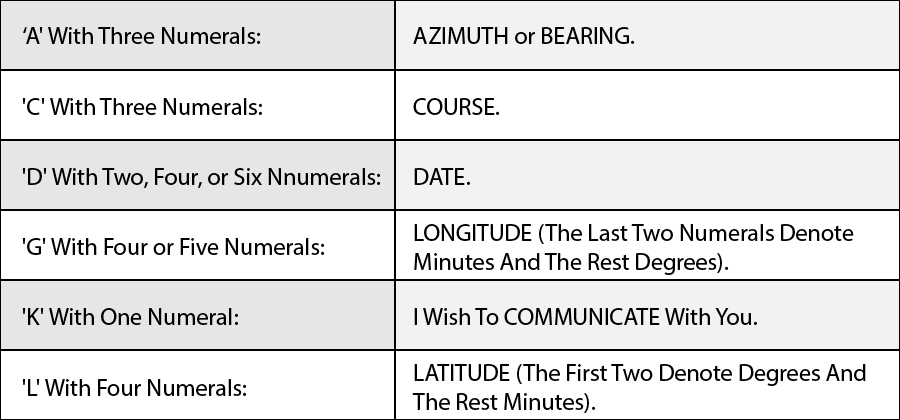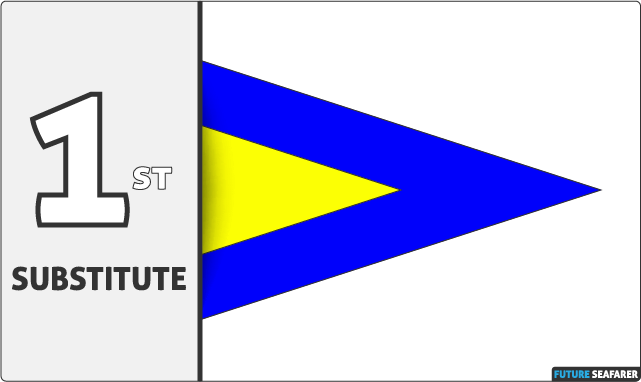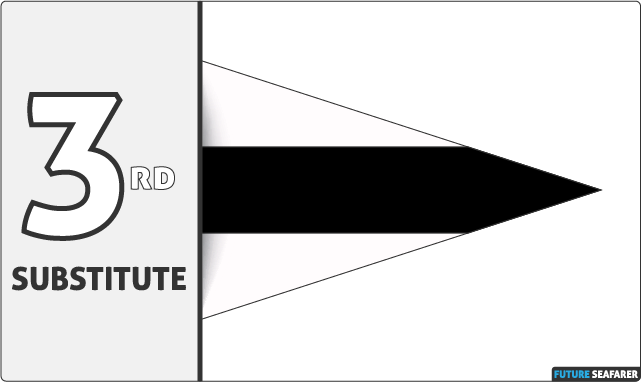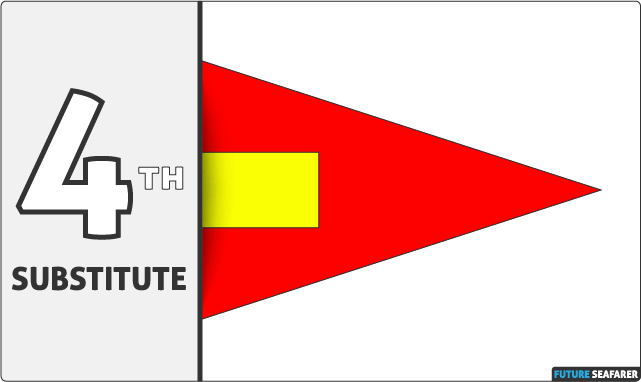The purpose of the International Code of Signals is to provide ways and means of communication in situations related essentially to safety of navigation and persons, especially when language difficulties arise.
- The signals are used consist of:
- Single-letter signals allocated to significations which are very urgent, important, or of very common use.
- Two-letter signals for General Signal Code.
- Three-letter signals beginning with “M” for Medical Signal Code.
- The methods of signaling which may be used are:
- Flag signaling.
- Flashing light signaling, using the Morse symbols.
- Sound signaling, using the Morse symbols
- Voice over a loud hailer.
- Radiotelegraphy.
- Radiotelephony.
- Morse signaling by hand flags or arms.
SIGNALS WITH COMPLEMENTS:
FLAG SIGNALING
HOW TO USE SUBSTITUTE FLAGS:
Substitute Or Repeater Flags Allow Messages With Duplicate Characters To Be Signaled Without The Need For Multiple Sets Of Flags.
- INTERNATIONAL CODE OF SIGNALS: Includes Only The First Three Of These Substitute Flags.
- NATO FLAGS: Includes All These Substitute Flags
EXAMPLE:
HOW TO USE ANSWER PENNANT:
The Main Use For The Answer Pennant Is For The Receiving Ship To Indicate That It Has Seen And Understood The Signal Hoisted By The Other Ship.
When A Ship Sets A Signal, The Receiving Ship Sets The Answer Pennant “AT THE DIP”, As Soon As It Has Seen The Signal. Then, When The Receiving Ship Has Understood The Signal, The Answer Pennant Is Hoisted “Close Up”.
- AT THE DIP: Halfway The Mast.
- CLOSE UP: To The Top Of The Mast.
MORSE CODE
Morse Code Is A Method Of Transmitting Text Information As A Series Of On-off Tones, Lights, Or Clicks That Can Be Directly Understood By A Skilled Listener Or Observer Without Special Equipment.
The International Morse Code Encodes The ISO (International Organization for Standardization) Basic Latin Alphabet, Some Extra Latin Letters, The Arabic Numerals And A Small Set Of PUNCTUATION & PROCEDURAL SIGNALS (PROSIGNS) As Standardized Sequences Of Short And Long Signals Called “Dots” And “Dashes” Or “Dits” And “Dahs”.
TRANSMITTING DURATION
- THE DOT DURATION: Is The Basic Unit Of Time Measurement In Code Transmission.
- DASH: Is Three Times The Duration Of A Dot.
- SPACE BETWEEN DOT OR DASH: Is Followed By A Short Silence, Equal To The Dot Duration.
- SPACE BETWEEN LETTERS OF A WORD: Are Separated By A Space Equal To Three Dots (One Dash).
- SPACE BETWEEN WORDS: Are Separated By A Space Equal To Seven Dots.
FLAG SEMAPHORE
FLAG SEMAPHORE (FLAG SIGN-BEARER)
- Is The Telegraphy System Conveying Information At A Distance By Means Of Visual Signals With Hand-held Flags, Rods, Disks, Paddles, Or Occasionally Bare Or Gloved Hands.
- Information Is Encoded By The Position Of The Flags; It Is Read When The Flag Is In A Fixed Position.
- Semaphores Were Adopted And Widely Used In The Maritime World In The 19th Century.
DEFINITION
- Numbers: can be signaled by first signaling “Numerals”.
- Letters: can be signaled by first signaling “J”.
- Attention: The sender uses the signal to request permission to begin a transmission.
- Ready to receive:
- The receiver uses to grant permission to begin the transmission.
- The sender ends the transmission with the “Ready to receive” signal.
- The receiver can reply with the “Attention” signal. At this point, sender and receiver change places.
MORSE SIGNALING BY HAND FLAGS OR ARMS
- A Station Which Desires To Communicate With Another Station By Morse Signaling By Hand Flags Or Arms May Indicate The Requirement By Transmitting To That Station The Signal “k1” By Any Method. The Call Signal “aa Aa Aa” May Be Made Instead.
- On Receipt Of The Call The Station Addressed Should Make The Answering Signal, Or, If Unable To Communicate By This Means, Should Reply With The Signal “ys1” By Any Available Method.
- The Call Signal “aa Aa Aa” And The Signal “t” Should Be Used Respectively By The Transmitting Station And The Addressed Station.
- Normally Both Arms Should Be Used For This Method Of Transmission But In Cases Where This Is Difficult Or Impossible One Arm Can Be Used.
- All Signals Will End With The Ending Signal “ar”.







